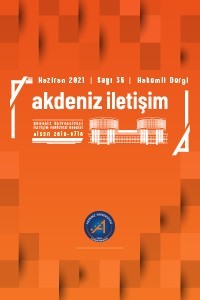AVUSTURALYA SİNEMASINDA ABORJİNLER: SONSUZ ÇÖLDEN ÇİT’E
Çalışma 30 yıllık sinema tarihiyle birbirinden ayrılan iki film ile Avustralya sinemasında Aborjin kültürüne yaklaşımı incelemektedir. İki film arasındaki benzerlikler ve farklar o dönemdeki tarihsel gelişmeler ışığında incelenmiş ve Avustralya ulusal sinema tarihine sırasıyla olan katkılarının altı çizilmiştir. Daha yakın tarihli film eski yıllarda Aborjinlere yapılan zulmün Avustralyalılar arasında daha geniş bir kabullenme olmasına karşın Hollywood sinematik uygulamaları üzerinden koloni öncesi kritikler ile kendini saldırıya açık bir hale getirmesi tartışılmıştır. Daha eski olan film küçümseyici ve duygusal yönleriyle eleştirilmiştir ancak sosyal ve etnik bölünmenin şiddetinden kendini korumuştur. İki filmin algısı ve etkisinin herhangi başkabir yerdeki ulusal sinemaların acil olarak karşılaştıkları belirli problemleri örneklerle anlatması tartışılmaktadır
Anahtar Kelimeler:
Avustralya Sineması, Ulusal Sinema, Aborjinler, Post-Sömürgecilik
THE ABORIGINE IN AUSTRALIAN CINEMA: FROM WALKABOUT TO RABBIT-PROOF FENCE
The essay examines the treatment of Aborigine culture in Australian film through a study of two films separated by thirty years of cinematic history. The similarities and differences between the two films are examined in the light of historical developments in that period, and their respective contributions to the history of national cinema in Australia are outlined. It is argued that the more recent film, despite its significance in the wider acceptance among Australians of the cruel treatment of the Aboriginal population in earlier periods, made itself vulnerable to attacks by pro-colonial critics through its utilisation of Hollywood cinematic conventions. The older film, wholly fictional and stylistically expressionistic, has been criticized as condescending and sentimental, but avoided the excerbation of social and ethnic divisiveness. The reception and impact of the two films, it is argued, illustrate significant problems confronted in the emergence of national cinemas elsewhere
Keywords:
Australian Cinema, National Cinema, Aborigines, Post-Colonialism,
___
- Adnum, M. (2002). Advertising Oz. Spiked Culture. May 28, 2002. http://www.spiked-online.com/Articles/00000006D909.htm.
- Akerman, P. (2002). Artistic Licence Spoils This Saga in Sunday Telegraph, March 3, 2002 p. 89.
- Becker Entertainment. (2002). Rabbit-Proof Fence media kit.
- Collins F. and Davis T. (2004). Australian Cinema after Mabo. Cambridge U.K.: Cambridge University Press.
- D'Aeth, T.H. (2002). Which Rabbit-Proof Fence? Empathy, Assimilation, Hollywood. In Australian Humanities Review at http://www.australian huanitiesreview.org/archive/Sept-2002.
- Dawson, J. (1971). Walkabout, in Monthly Film Bulletin 38/455, pp. 227-228.
- Gibson, R. (1992). South of the West: Postcolonialism and the Narrative Construction of Australia. Indianapolis: Indiana University Press.
- Human Rights and Equal Opportunity Commission (1997): Bringing Them Home: National Enquir into the Separation of Aboriginal and Torres Strait Islander Children from Their Families. Sydney, April.
- Kolker, R. (2000). A Cinema of Loneliness. New York: Oxford University Press.
- McFarlane B. and Mayer G. (1992). New Australian Cinema: Sources and Parallels in American and British Film. Cambridge UK: Cambridge University Press.
- Naficy, H. (2001). An Accented Cinema. Princeton N.J.: Princeton University Press.
- Nowra, L. (2003). Walkabout. New South Wales: Currency Press.
- Noyce, P. (2002). Rabbit-Proof Defence. Sunday Telegraph, 10 March 2002, p. 99.
- O'Regan, T. (1996). Australian National Cinema. London: Routledge.
- O'Regan, T. (1985). The Man from Snowy River and Australian Popular Culture. In Moran A. and O'Regan T. (eds.) An Australian Film Reader. Sydney: Currency Press.
- Pilger, J. (2002). The New Rulers of the World. London: Verso.
- Pilkington-Garimara, D. (1996). Follow the Rabbit-Proof Fence St. Lucia: University of Queensland Press.
- Rayner, J. (2000). Australian Cinema. Manchester: Manchester University Press.
- Tatz, C. (1998). Genocide in Australia. Australian Institute of Aboriginal and Torres Strait Islander Studies. December 1998.
- Willemen, P. (1989). The Third Cinema Question: Notes and Reflections. In Pines J. and Willemen P. (eds.) Questions of Third Cinema, p.1-29. London: British Film Institute.
- Yayın Aralığı: Yılda 3 Sayı
- Başlangıç: 2003
- Yayıncı: Akdeniz Üniversitesi
